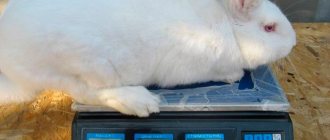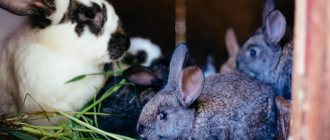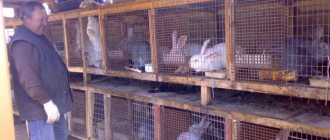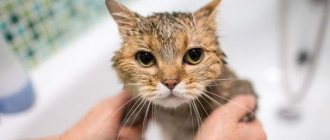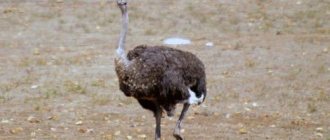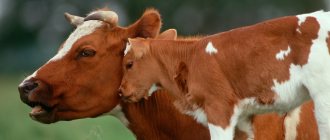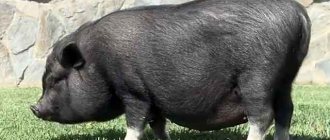Rabbit breeding is a fairly popular type of business. The fertility and early maturity of these animals are a significant advantage. Dietary meat is in demand. However, in order to raise healthy offspring, it is necessary to become familiar with the intricacies of this process. When breeding mammals, the owner of the animals receives not only meat, but also skins, fluff and fertilizers, which can be sold. If you properly care for the living creatures, the female will be able to reproduce 5-6 times a year. Below you can find information about how rabbits are born and how to properly care for the female and her offspring.
What is birth called in rabbits?
Mammals are endowed with the ability to reproduce frequently. Beginning livestock breeders are interested not only in the question of how rabbits give birth, but also in the correct name for this process. Veterinarians call the birth of rabbits a litter (another name for lambing). The duration of a rabbit's pregnancy can reach 40 days. The birth process occurs exclusively in the absence of people near the cage with the mammal. If the birth proceeds without complications, then no assistance during childbirth is required.
Rabbit farming is a popular type of business
Important! A few weeks before giving birth, the female is placed in a queen cell, which is filled with a large amount of hay and straw, which the animal uses to build a nest.
A pregnant rabbit is a pregnant female. How often do rabbits give birth? If the pregnant female is healthy, then in a year you can get up to 5-6 litters from her (weaker females give birth twice, three times a year). High precocity is a distinctive feature of mammals.
The birth of a female rabbit may begin not on the 40th day, but on the 32nd, so it is better to start preparing for the birth in advance. During pregnancy, the behavior of animals remains the same. However, some individuals can become aggressive, like wild hares, or begin searching for a secluded place where they can hide from humans. During this period, it is better not to disturb the animal often and provide it with a comfortable and calm environment.
Artificial feeding
Young animals eat from 2 to 6 am. It is necessary to ensure that their tummies are always full. If the mother refuses to feed them, then she needs to be put in a cage with the babies and watched for 15 minutes. During this time, she should begin to feed the babies. If the situation has not changed, then you need to start looking for another female.
How to prepare milk replacer for baby rabbits:
- 250 ml of whole milk is mixed with one chicken yolk.
- Molasses and a few drops of liquid vitamins are added to the composition.
To properly feed babies, they need to be handled with care. Many breeders are concerned about the question: is it possible to touch newborn rabbits? They can be taken, but they must be handled very carefully. It is important not to crush or suffocate them. For the artificial feeding procedure, you will need a bottle of medicine and a cotton swab.
The mixture will seep through the cotton wool, reminding babies of their mother's nipples. The rabbits themselves must stop sucking. The cubs themselves know their dose of feeding. Feeding is done every 5-8 hours. The survival rate of the offspring depends on the feeding technique. The process should be similar to natural feeding.
How many rabbits does a female rabbit give birth to at one time?
How many times does a mother rabbit feed her babies per day?
How many rabbits does a mother rabbit bring? This question worries every novice livestock breeder. The number of offspring may depend not only on breed membership, but also on personal reproductive characteristics. In the first birth, the mammal is capable of bringing about 3-5 young rabbits. Only in rare cases does the female bring a little more rabbits.
Representatives of different breeds can produce different numbers of rabbits. Moreover, the average is the same for all mammals. Starting from the second birth, the number of babies increases. Now a female can give birth to 7-10 rabbits. If there are more individuals in the litter, this can cause weakness in the newborns, because the mother is not able to fully feed such a horde.
Multiple pregnancies cause poor health of offspring
It is also important to know what is the best age for a female to give birth to rabbits at home. It is advisable to use breeding individuals for the first three years of their life, and commercial females are not used for longer than 12 months, despite the fact that the average life expectancy of mammals can reach 7 years.
Note! By providing proper care and care, you can increase the lifespan of your decorative rabbit to 12 years.
Adviсe
Everything else you need to know at the time of pregnancy and childbirth:
- It is not recommended to palpate the abdomen of a pregnant rabbit after mid-pregnancy. This can contribute to birth defects and death.
- It is good to palpate the female’s abdomen before mating. Next, it will be easy to understand if the rabbit is expecting a litter. Rabbits will be clearly recognizable to the touch even at an early stage of pregnancy.
- Mom covers her offspring with her down. It needs to be checked periodically to ensure newborns have access to air.
- Try not to touch a pet that has just given birth; she may bite painfully and experience stress.
- The male must be kept separate from the pregnant and lambing mother and her offspring.
Rabbits combine two interesting qualities: they are unpretentious, but with a subtle psyche. This must be taken into account when caring for the expectant mother and her babies.
Preparing for birth
It is not recommended to pick up pregnant females or hold them close to you. However, if it becomes necessary to transfer the mammal to another nest, you should lift it by the withers with one hand, and carefully hold it below with the other.
How long do pregnant cats walk for the first time?
Below you can familiarize yourself with the features of preparing a pregnant individual for childbirth.
- It is recommended to start preparing for litter on the 26th day after mating. The female is transferred to another cage. The rabbits from the previous litter are moved away from her.
- The breeding cage is pre-cleaned, washed and disinfected.
- Now you can move the prepared cage to a convenient place (not on the street), and a queen cell, which is covered with a thick layer of straw, is placed inside the cage.
- At this time, the pregnant individual will build a nest in the queen cell. To this end, the rabbit will begin to crush the straw with her teeth and put it in a pile. Having plucked the fluff from her chest area, the female will cover the nest.
- In the sultry heat, it is advisable to remove a small part of the fluff that the female has plucked. If the rabbits are too hot, they will crawl to the sides. In the cold season, it is worth helping the mammal pinch the fluff and cover its warm nest with it.
- A few days before the expected birth date, it is important to re-inspect the nest. It is unacceptable to transfer a female from one cage to another before giving birth.
- There must be a container with clean drinking water in the cage.
Note! Rabbits give birth quickly. The duration of the birth reaches 20-40 minutes. Childbirth most often takes place at night or early in the morning. If there are no complications, it is better not to interfere with this process.
A pregnant rabbit needs to be housed separately
How to deliver a baby
Depending on the individual characteristics of the animal’s body, we can talk about what day the birth will begin. As a rule, in most cases, birth occurs on the 31st-32nd day. However, it is important to be prepared for the fact that the appearance of baby rabbits is possible on the 27th day.
Why does a mother rabbit eat her newborn rabbits?
Depending on how the rabbit gives birth, we can talk about whether human intervention is required in this process or not. Quite often, the livestock breeder is required to exclusively control the birth. It is important that the female gives birth on the straw and not on the bare floor of the cage. Rabbits can die from hypothermia. This is why before the rabbits are born, the breeder must line the entire cage with a thick layer of straw.
Providing assistance is advisable in cases where a female gives birth to giants (large-sized rabbits). This is why it is so important to periodically enter the room and double-check that everything is in order. Most often, the duration of labor does not exceed 20-40 minutes (in nature).
Important! In case of any complications, the birth may last a whole day.
As soon as the birth process comes to an end, the female begins to lick the offspring. At this moment, it is important to count the cubs and transfer those that have fallen from the nest onto the straw into the nest. Before picking up the babies, you should remove the human smell and take the rabbit out of the cage for 10 minutes (otherwise there is a risk that she will refuse to feed the offspring). To do this, rub your hands with down and straw located in the nest. After 10-20 minutes you can bring the female into the nest.
You can pick up offspring only after their skin is covered with fur.
The rabbit gave birth, what to do next? If the birth was successful, the baby rabbits feel well, it is better not to disturb the mother and the children for a couple of days.
Aggressive females
Sometimes after giving birth the female becomes very aggressive
In this case, you need to take care of the rabbit and her cubs with great care. Remember: aggression is a sign that the mother rabbit is trying to protect her babies from any potential danger.
Another misconception is that female rabbits often kill their offspring during or immediately after birth: by eating the babies, crushing them, or simply letting them die. Indeed, sometimes babies get eaten
But it is important to note that rabbits are non-carnivorous animals.
If you pay attention to the circumstances under which the babies were eaten, you can find the answer to why this happened. The complete absence of maternal instincts is not typical for rabbits; often we simply do not understand the motives for the behavior of our pets
A mother rabbit may accidentally crush her babies when she was actually trying to protect them. The appearance of a predator, loud or unfamiliar sounds and other frightening factors can force the mother rabbit to drop everything and rush to her offspring to protect them. Having jumped into the nest in order to protect her babies, the rabbit may accidentally crush them. To avoid this situation, it is recommended to move the rabbit's cage to a safer and quieter place. Sometimes a female rabbit can accidentally injure her young if her claws are not trimmed.
Caring for baby rabbits in the first weeks of life
The birth of baby rabbits is a complex process, but the birth of babies is not a guarantee that all of them will be able to survive. To ensure the full development and rapid growth of the cubs, it is worth feeding their mother correctly. If there is a lack of milk, the offspring will begin to quickly lose weight. The rabbits will look lethargic and frail. Gradually, the hungry babies will crawl out of the nest and die. By providing the female with the correct diet after childbirth, this problem can be avoided.
For your information! It is recommended not to disturb small rabbits for the first 24 hours after giving birth. During this period, the cubs are busy eating colostrum, and the female recovers from the stress she has experienced.
It is advisable to check the babies and their mother 24 hours after birth. If sick cubs are discovered, it is important to isolate them in a separate cage as soon as possible and begin treatment. During this period, it is worth feeding them artificial nutrition. The condition of the rabbit and babies will need to be closely monitored over the next few days.
Grown rabbits need fresh grass
What to feed a rabbit after giving birth during lactation
After the female has stopped breeding, it is important to take care of a balanced diet that allows her to produce a sufficient amount of milk. It is impossible to guess exactly how much milk a particular individual will produce, which contains a large percentage of protein. However, on average, a mammal can produce 180-210 g.
Important! The animal's food should contain enough protein - 20 g for every 100 g of food.
In the first 28-30 days after giving birth, it is necessary to include grass that stimulates lactation in the animal’s diet:
- parsley;
- dill;
- elecampane.
It is also important to fill feeders with plenty of freshly cut grass and fresh hay (in winter). A small percentage is added to the feed:
- raw potatoes;
- fresh carrots;
- fresh cabbage;
- fish oil;
- meat and bone meal;
- salt;
- chalk.
It is important to provide a nursing mother with a varied diet. During the cold season, it is recommended to give mash every day, which includes oats, bran and mineral supplements.
Baby rabbits need to be fed properly
How long after birth can a female rabbit be born?
How quickly after giving birth can a baby rabbit be born? If the litter went without complications, mating can be carried out after 40-50 days. However, in cases of stillbirth, it is important to understand the reasons that provoked the occurrence of this situation. If necessary, it is important to eliminate as soon as possible undesirable factors leading to stillbirth.
If the rabbits were stillborn due to stress, then mating does not need to be postponed. If the cause of such a problem is past pathologies, it is important to cure the animal and postpone mating for several months.
Note! When stillbirths occur frequently, it is important to replace the female with one that will be able to give birth to healthy young.
What to do if a rabbit gives birth to save offspring
There are several rules that must be followed if the rabbit breeder does not want the female rabbit to eat her rabbits:
- Firstly, the female rabbit and her offspring need peace;
- You can’t just pick up newly born rabbits. Rabbits are very sensitive to odors, and many experienced rabbit breeders know this, and therefore do not use any perfume during grooming;
- Before and after giving birth, the rabbit should have clean water and enough food in the cage. It is most often due to the lack of water and food that the female rabbit eats her rabbits.
And, of course, you need to make sure that there are no rats in the rabbitry. Rats, like some other rodents, are always willing to feast on newborn rabbits, which they can smell a mile away.
Therefore, every rabbit breeder who has already dealt with this problem makes sure that there are no holes in the cages. It is through them that the rat enters the cage, leaving behind a terrible sight.
Source
Prevention of abortion in rabbits
In order to prevent abortions in mammals, the recommendations below should be followed.
- The norms of free space for keeping each female must be strictly observed.
- Animals must be fed according to a schedule.
- Only good quality food can be present in the diet.
- Matings take place according to the time limits recommended by experts. Too frequent matings have a negative impact on the health of animals. The offspring are born weakened and sometimes die during childbirth.
- The cages of pregnant animals should be clean and spacious.
- Timely vaccination is an excellent prevention of the development of most diseases.
To prevent miscarriages, you need to provide the rabbit with good living conditions.
By following all the rules and recommendations, you can get healthy offspring from females. In addition, it is important to observe the timing of mating of individuals. In this case, the rabbit breeding business will quickly pay for itself and bring the desired profit.
When babies are separated from their mother
The offspring are separated when they can feed on solid food on their own.
How does weaning happen:
- If baby rabbits are dependent on mother's milk, then they should not change their diet. Otherwise, it will have a detrimental effect on your health.
- Transferring baby rabbits to another cage is accompanied by stress. Therefore, they need to be transplanted and accustomed to other conditions gradually.
- The young are separated at the age of 35−45 days after birth.
